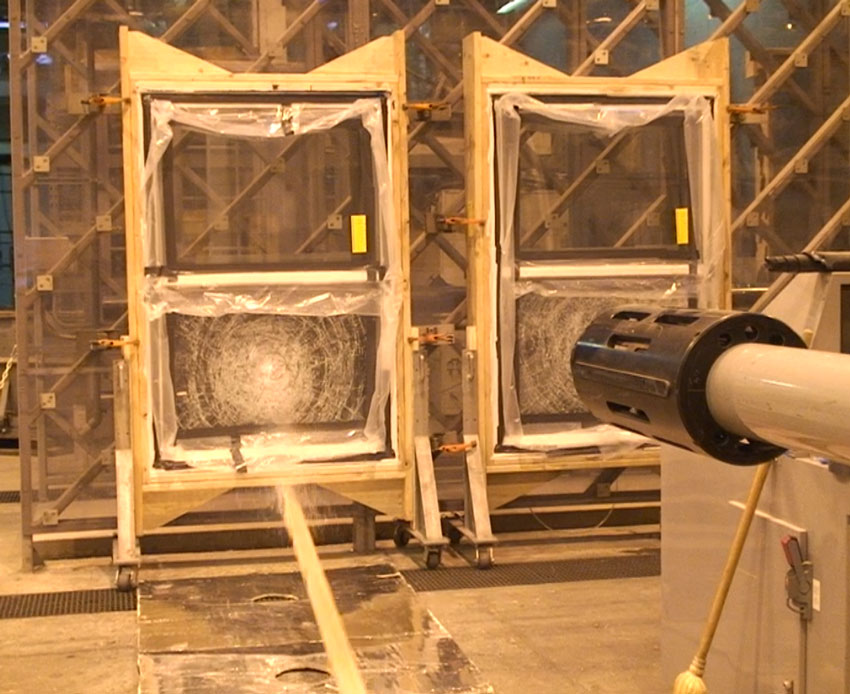Shelter from the Storm
Disaster Response: Hurricane-Resistant Requirements for Windows
ASCE 7
ASCE 7: Minimum Design Loads for Buildings and Other Structures provides requirements for general structural design and includes means for determining dead, live, soil, flood, wind, snow, rain, atmospheric ice, and earthquake loads, as well as their combinations, which are suitable for inclusion in building codes and other documents. These measures have been put in place to protect both property and lives as a result of significant changes in the building codes over the past two decades. Many codes and standards now contain hurricane provisions. Codes originally developed for Florida have expanded from Texas, along the Gulf, and up through the Atlantic seaboard to Maine. Windborne debris requirements are significant new factors in model building codes.
The American Society of Civil Engineers (ASCE) 7 is referenced in major U.S. model building codes. Hurricane provisions in ASCE 7 include:
- Definition of Hurricane-prone regions and Windborne debris regions
- Definition of impact-resistant glazing and impact-resistant coverings
Under ASCE 7, hurricane-prone regions are defined as U.S. Atlantic Ocean and Gulf of Mexico coasts where the basic wind speed is greater than 115 mph, as well as Hawaii, Puerto Rico, Guam, Virgin Islands, and American Samoa.
Wind debris regions are those areas within hurricane-prone regions located either within 1 mile of the coastal mean high water line, where the basic wind speed is equal to or greater than 130 mph, and in Hawaii, or in areas where the basic wind speed is equal to or greater than 140 mph.
Under this definition, a large portion of U.S. coastal regions fall within ASCE 7 requirements; all coastal areas from Texas to Maine are now regarded within ASCE 7 governance.
The current version of ASCE 7 is ASCE 7-10. Wind design in ASCE 7-10 incorporates several major changes. ASCE 7-10 wind maps are based on “ultimate strength” wind speeds, as opposed to “allowable stress” wind speeds used in ASCE 7-05. Additionally, ASCE 7-10 introduces new wind speed maps that vary by risk category instead of occupancy category. Risk category for a structure is rated as either a I, II, III, or IV and is defined by the nature of occupancy of the building.
- Risk Category I: Low hazard to human life. Examples include agricultural facilities, certain temporary facilities, and minor storage facilities.
- Risk Category II: Any building and other structure not listed in Categories I, III, and IV; Residential homes.
- Risk Category III: Substantial hazard to human life. Examples include building and other structures whose primary occupancy is public assembly, with an occupant load greater than 300; buildings and other structures containing elementary, secondary school, or day-care facilities with an occupant load greater than 250; adult education facilities with an occupant load greater than 500.
- Risk Category IV: Designation as an essential facility. Essential facilities include, but are not limited to, fire, rescue, ambulance and police stations, and emergency vehicle garages; designated earthquake, hurricane, or other emergency shelters; power-generating stations and other public utilities facilities required as emergency backup facilities; Categories I and II occupancies having surgery or emergency treatment facilities; buildings and other structures having critical national defense functions.

Photo courtesy of Graham Architectural Products
Under ASCE 7-10, a building’s purpose and occupancy level help determine risk. Structures containing elementary and secondary schools are viewed as higher risk and subject to more stringent requirements. Hurricane-resistant windows are featured throughout historic Leon High School in Tallahassee, Florida.
The International Building Code (IBC) and Florida Building Codes reference ASCE 7 to calculate a project’s “design pressure.”
After defining where hurricane-prone regions and windborne debris regions are, and setting structure risk categories, ASCE 7 also mandates debris impact provisions. These provisions can be divided into two categories:
- Glazing, impact-resistant: Glazing which has been shown by an approved test method to withstand the impact of windborne missiles likely to be generated in windborne debris regions during design winds.
- Impact-resistant covering: A covering designed to protect glazing, which has been shown by an approved test method acceptable to the authority having jurisdiction to withstand the impact of windborne missiles likely to be generated in windborne debris regions during design winds.
Glazing located more than 60 feet above ground and more than 30 feet above aggregate surface roof debris located within 1,500 feet of the building shall be permitted to be unprotected. To assure compliance, ASCE 7 references ASTM E1886 and E1996 testing methods for windborne debris performance validation.
Verifying Window Performance under ASCE 7
Impact and cycling tests have been developed to simulate large and small windborne debris encountered during a hurricane. Application of these tests demonstrates whether glazing and coverings are impact resistant. Positive and negative pressure cycling is also imposed on the products to reproduce the extreme gusts of wind during the hurricane event.
Tests evaluate two categories of debris encountered during a hurricane:
- Large missiles: Objects such as timbers, roof tiles, sheet metal, and bricks that fly or tumble near ground. Impact speed 1/3 to 1/2 of wind stream velocity. Larger missiles tended to fly and tumble within 30 feet of the ground, while small missiles fly at heights up to 30 feet above small missile sources. Large missiles such as roof tile, concrete blocks, timbers, sheet metal, and fascia are common during a hurricane. For testing, the 2-foot by 4-foot timber was determined to be representative of objects that commonly fly in hurricanes and was found to be easily propelled from an air cannon in a repeatable manner. Several different masses of 2-foot by 4-foot timbers have been defined for design use.
- Small missiles: Objects such as roof gravel or glass particles that fly at rooftop elevations. Impact speed 90 percent of wind stream velocity. Small missiles tend to fly at greater heights than large missiles. The most common small missile is roof gravel, but broken glass particles, bits of roofing material, and small chips of concrete and clay tile also have been observed. A 2-gram steel ball is considered representative of small missiles that fly in windstorms and is used during testing.

Photo courtesy of Graham Architectural Products
During launch missile impact testing, a 2-inch by 4-inch wood stud traveling nearly 35 mph is launched at the center of the window. To pass this phase, a window must successfully withstand impacts at the center and corner of the window.
ASTM E1886/1996 are the national consensus test method and specifications for windborne debris impacts in hurricanes.
The American Society for Testing & Materials (ASTM) has strict guidelines (E1886 and E1996) for impact-resistant windows before they can be certified as impact resistant. The debris impact test method is defined by ASTM E1886-02; specific impact requirements are defined in specification ASTM E1996-02. ASTM E1996 augments ASTM E1886 by specifying the weight of the large missile to be used in testing per ASTM E1886 and the impact velocities for the large and small missiles. The ASTM standards identify more stringent requirements for buildings in higher basic wind speed zones and for critical facilities.
Codes will vary by community, but generally, impact-resistant windows must meet these basic guidelines:
- The first test is called a launch missile impact test. A 9-pound, 2-inch by 4-inch wood stud is launched at 50 feet per second (fps), or almost 35 miles per hour, at the center of the window. If the window doesn’t fail, another stud is then shot at one of the corners of the window. Both the center and the corner of the window must be able to hold together to pass this test. Hurricane-prone Florida has slightly tougher testing standards, requiring windows to withstand boards launched at 80 fps.
- After the launch missile impact test, the window is then subjected to pressures that simulate winds of up to 200 miles per hour. If the window remains intact within the frame, it can be certified as an impact-resistant window.

Photo courtesy of Graham Architectural Products
Selecting impact-resistant windows, rather than shutter systems, allows for preservation of design and total preparedness of a structure during a storm. On the National Register of Historic Places, The Cigar Factory in Charleston, South Carolina, selected hurricane-resistant windows to preserve its Victorian-era industrial facade.
A product is considered large missile resistant after it has been exposed to various impacts with a piece of lumber weighing approximately 9 pounds, measuring 2 inches by 4 inches by 6 feet (no more than 8 feet) in size, traveling at a speed of 50 feet per second (34 mph). Then the product must pass positive and negative wind loads for 9,000 cycles, with impact creating no hole larger than 1/16 by 5 inches in the interlayer of the glass.
A product is considered small missile resistant after it has been exposed to various impacts with 10 ball bearings traveling at a speed of 80 feet per second (50 mph). The product is then subjected to wind loads for 9,000 cycles.
For buildings where doors and windows are located 30 feet or less above grade (e.g., above ground level), the products must pass the large missile test. If the doors and windows are more than 30 feet from the ground, they must be either large or small missile certified.
Impact-resistant windows offer several advantages over shutters. A product with hurricane-resistant status will offer 24-hour protection with no action required. Windows that are hurricane-resistant offer a more aesthetically appealing alternative to shutters. The use of impact-resistant windows and doors may also help reduce insurance premiums.
Other impact test standards may be encountered during project specification, depending on job location. These include Testing Application Standard (TAS) 201, 202, and 203 and Miami Dade Impact and Cycling Codes in the Florida Building Code (FBC).

Photo courtesy of Graham Architectural Products
Project: The Conservatory at Hammock Beach
To withstand the rigors of testing and secure a hurricane-resistant rating, hurricane-resistant windows require special glazing and extra attention to both frame and assembly.









